
Demographic features of the population of Hungary include population density, ethnicity, education level, health of the populace, economic status, religious affiliations and other aspects.
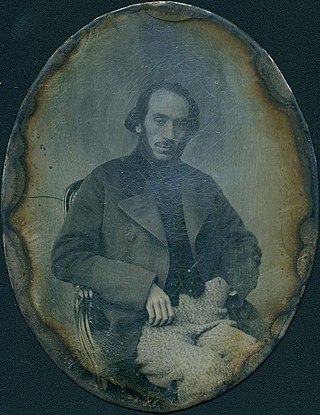
Nicolae Bălcescu was a Romanian Wallachian soldier, historian, journalist, and leader of the 1848 Wallachian Revolution.

The Democratic Alliance of Hungarians in Romania is a political party in Romania which aims to represent the significant Hungarian minority of Romania.

Gyula is a town in Békés County, Hungary. The town is best known for its medieval castle and a thermal bath. Ferenc Erkel, the composer of the Hungarian national anthem, and Albrecht Dürer the Elder, the father of Albrecht Dürer, were also born in Gyula.

Békés is an administrative division in south-eastern Hungary, on the border with Romania. It shares borders with the Hungarian counties Csongrád, Jász-Nagykun-Szolnok, and Hajdú-Bihar. The capital of Békés county is Békéscsaba. The county is also part of the Danube-Kris-Mures-Tisa euroregion.

Romanians in Serbia are a recognized national minority in Serbia. The total number of self-declared Romanians according to the 2022 census was 23,044, while 21,013 people declared themselves Vlachs; there are differing views among some of the Vlachs over whether they should be regarded as Romanians or as members of a distinctive nationality. Declared Romanians are mostly concentrated in Banat, in Vojvodina, while declared Vlachs are mostly concentrated in the Timok Valley, in eastern Serbia.
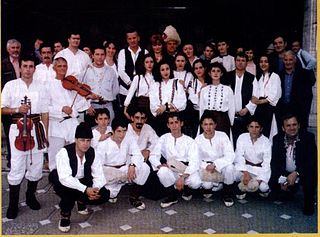
The Vlachs are a Romanian-speaking population group living in eastern Serbia, mainly within the Timok Valley. They are characterized by a culture that has preserved archaic and ancient elements in matters such as language or customs. Their ethnic affiliation is highly disputed, with some considering the Vlachs as an independent ethnic group while others consider them part of the Romanians.

Transylvania is a historical region in central and northwestern Romania. It was under the rule of the Agathyrsi, part of the Dacian Kingdom, Roman Dacia (106–271), the Goths, the Hunnic Empire, the Kingdom of the Gepids, the Avar Khaganate, the Slavs, and the 9th century First Bulgarian Empire. During the late 9th century, Transylvania was part of the Hungarian conquest, and the family of Gyula II of the seven chieftains of the Hungarians ruled Transylvania in the 10th century. King Stephen I of Hungary asserted his claim to rule all lands dominated by Hungarian lords, and he personally led his army against his maternal uncle Gyula III. Transylvania became part of the Kingdom of Hungary in 1002, and it belonged to the Lands of the Hungarian Crown until 1920.

The Romanian diaspora is the ethnically Romanian population outside Romania and Moldova. The concept does not usually include the ethnic Romanians who live as natives in nearby states, chiefly those Romanians who live in Ukraine, Hungary, Serbia, and Bulgaria. Therefore, the number of all Romanians abroad is estimated at 4–12 million people, depending on one's definition of the term "Romanian" as well as the inclusion respectively exclusion of ethnic Romanians living in nearby countries where they are indigenous. The definition of "who is a Romanian?" may range from rigorous conservative estimates based on self-identification and official statistics to estimates that include people of Romanian ancestry born in their respective countries as well as people born to various ethnic-minorities from Romania. As of 2015/16, over 97% of Romanian emigrants resided in OECD countries; and about 90% of Romanian emigrants in OECD countries lived in Europe, with the most common country of residence being Italy. The vast majority of Romanian emigrants are based in just ten countries, with the most common countries being Italy, Germany, Spain, United Kingdom, United States, Hungary, France and Canada.
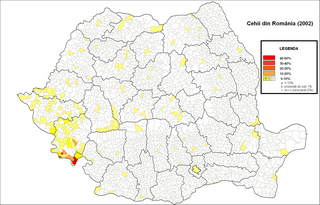
The Czechs are an ethnic minority in Romania, numbering 3,938 people according to the 2002 census. The majority of Romanian Czechs live in the south-west of the country, with around 60% of them living in Caraș-Severin County, where they make up 0.7% of the population.

Bățani is a commune in Covasna County, Transylvania, Romania. It lies in the Székely Land, an ethno-cultural region in eastern Transylvania.

Hungarian-Romanian relations are foreign relations between Hungary and Romania dating back to the Middle Ages and continuing after the Romanian unification in 1859 and independence in 1877. In the past, they involved Wallachia and Moldavia.

Andrei Mocioni de Foen was an Austrian and Hungarian jurist, politician, and informal leader of the ethnic Romanian community, one of the founding members of the Romanian Academy. Of a mixed Aromanian and Albanian background, raised as a Greek Orthodox, he belonged to the Mocioni family, which had been elevated to Hungarian nobility. He was brought up at his family estate in the Banat, at Foeni, where he joined the administrative apparatus, and identified as a Romanian since at least the 1830s. He rose to prominence during the Hungarian Revolution of 1848: he was a supporter of the House of Lorraine, trying to obtain increased autonomy for Banat Romanians in exchange for loyalism. The Austrians appointed Mocioni to an executive position over that region, but curbed his expectations by including the Banat as a whole into the Voivodeship of Serbia. This disappointment pushed Mocioni to renounce politics during much of the 1850s.
The 1848–1849 massacres in Transylvania were committed in the Hungarian Revolution of 1848. According to Hungarian historian Ákos Egyed, 14,000 to 15,000 people were massacred in Transylvania in this period. The victims comprised 7,500–8,500 Hungarians, 4,400–6,000 Romanians, and about 500 Transylvanian Saxons, Armenians, Jews, and members of other groups.

Prokopije or Procopius was an Austro-Hungarian cleric of the Romanian Orthodox and Serbian Orthodox churches who ultimately served as the latter's Patriarch at Karlovci. He was born in the Banat as a subject of the Austrian Empire, his ethnic affiliations alternating between the Serb and Romanian communities. Ivačković's early life was spent in Serbian Orthodox institutions, and he was seen as a Serb loyalist before he became Bishop of Arad. During the 1860s, he expressed support for Romanian nationalism, primarily as a founder of the National Aradian Association for Romanian Popular Culture. He backed Andrei Șaguna's bid to set up the Romanian-centered Metropolis of Transylvania, becoming its suffragan bishop; during the Serb–Romanian church partition, he extended the Arad Bishopric south into the Banat.
Aurel Suciu was an Austro-Hungarian ethnic Romanian lawyer and political activist.
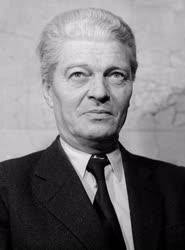
István Kniezsa was a Hungarian linguist and Slavist, corresponding (1939) and regular (1947) member of the Hungarian Academy of Sciences. He was one of the most significant figures in Hungarian language historical research in the 20th century, achieving significant scientific results in the study of place and personal names in the Carpathian Basin, in researching the medieval state and writing practice of the Hungarian language, as well as in the exploration of foreign words of Slavic origin. His major contribution was to the research of Slavic loanwords in the Hungarian language and toponymy. He was awarded by Kossuth Prize in 1953.
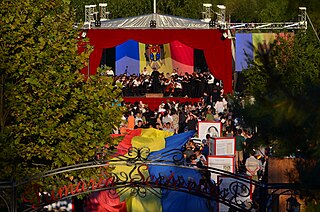
The Romanian Language Day is a public holiday in Romania and Moldova celebrated every 31 August for the Romanian language. Romanian is a Romance language, being part of the same linguistic family as the French, Italian, Portuguese and Spanish languages.
Foaia Românească is a weekly newspaper published in Hungary for the Romanian minority of the country. It was the first newspaper established for the Romanian minority of post-Trianon Hungary and it is the one with the longest and widest level of circulation within the country.
Maria Berényi is a Hungarian historian and poet of Romanian ethnicity. Born in Méhkerék, she studied in the Eötvös Loránd University in Budapest and has a doctorate in philology from the university and a doctorate in history from the Babeș-Bolyai University in Cluj-Napoca, Romania. She has been the director of the Research Institute of the Romanians of Hungary in Gyula since 1993.


















